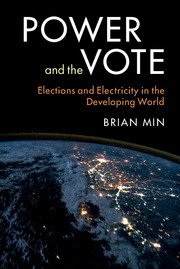Book contents
- Frontmatter
- Dedication
- Contents
- List of Figures
- List of Tables
- Acknowledgments
- 1 Introduction
- 2 Public Goods, Elections, and the Poor
- 3 Power and the State
- 4 Measuring Electricity from Space
- 5 Democracy and Light
- 6 Lighting the Poor
- 7 Electrifying India
- 8 Conclusion
- Appendix Satellite-Derived Estimates of Electrification
- References
- Index
4 - Measuring Electricity from Space
Published online by Cambridge University Press: 05 November 2015
- Frontmatter
- Dedication
- Contents
- List of Figures
- List of Tables
- Acknowledgments
- 1 Introduction
- 2 Public Goods, Elections, and the Poor
- 3 Power and the State
- 4 Measuring Electricity from Space
- 5 Democracy and Light
- 6 Lighting the Poor
- 7 Electrifying India
- 8 Conclusion
- Appendix Satellite-Derived Estimates of Electrification
- References
- Index
Summary
Introduction
On September 4, 1882, Thomas Edison flipped a switch at his Pearl Street Station and electric lights flickered on across lower Manhattan. So began the era of electric power transmission, setting off the proliferation of power plants distributing electrical power across the world. Yet today, 1.3 billion people continue to lack electricity, relying instead on kerosene, wood, and agricultural residues to meet their energy needs (International Energy Agency 2013). Where do these 1.3 billion people reside? And what do they reveal about how their governments choose to electrify some before others, and some not at all?
Despite its significance, there are little reliable data on how electricity is distributed in much of the developing world. High levels of uncertainty pervade official estimates of electrification rates, a vital and basic public service that is typically provided by governments in most of the rural world. Surveys from the World Bank, the Demographic and Health Surveys (DHS), and household survey programs provide invaluable data on household electrification rates and use. But these exist only for a subset of countries and rarely enable estimation of electrification rates at lower sub-national levels. Moreover, such surveys are expensive and difficult to conduct in areas that are remote, dangerous, or without the cooperation of local officials.
This book proposes a new method to estimate the provision of electrification using satellite imagery of the earth at night to identify lit and unlit areas across the globe. Stable concentrations of outdoor lighting are a uniquely good indicator of electricity access, because electricity is the most reliable energy source for outdoor illumination of streets and buildings and the only source that can do so at the levels required for satellite detection. Compared with traditional data on energy production and consumption, the satellite images explicitly reveal the geographic distribution of electrical power, providing a clearer picture of who benefits from electricity across every corner of the globe.
Satellite Imagery of Nighttime Lights
Since the early 1970s, the Defense Meteorological Satellite Program's Operational Linescan System (DMSP-OLS) has been flying in polar orbit capturing high-resolution images of the entire earth each night, typically between 7PM and 10PM local time.
- Type
- Chapter
- Information
- Power and the VoteElections and Electricity in the Developing World, pp. 51 - 73Publisher: Cambridge University PressPrint publication year: 2015
- 1
- Cited by



